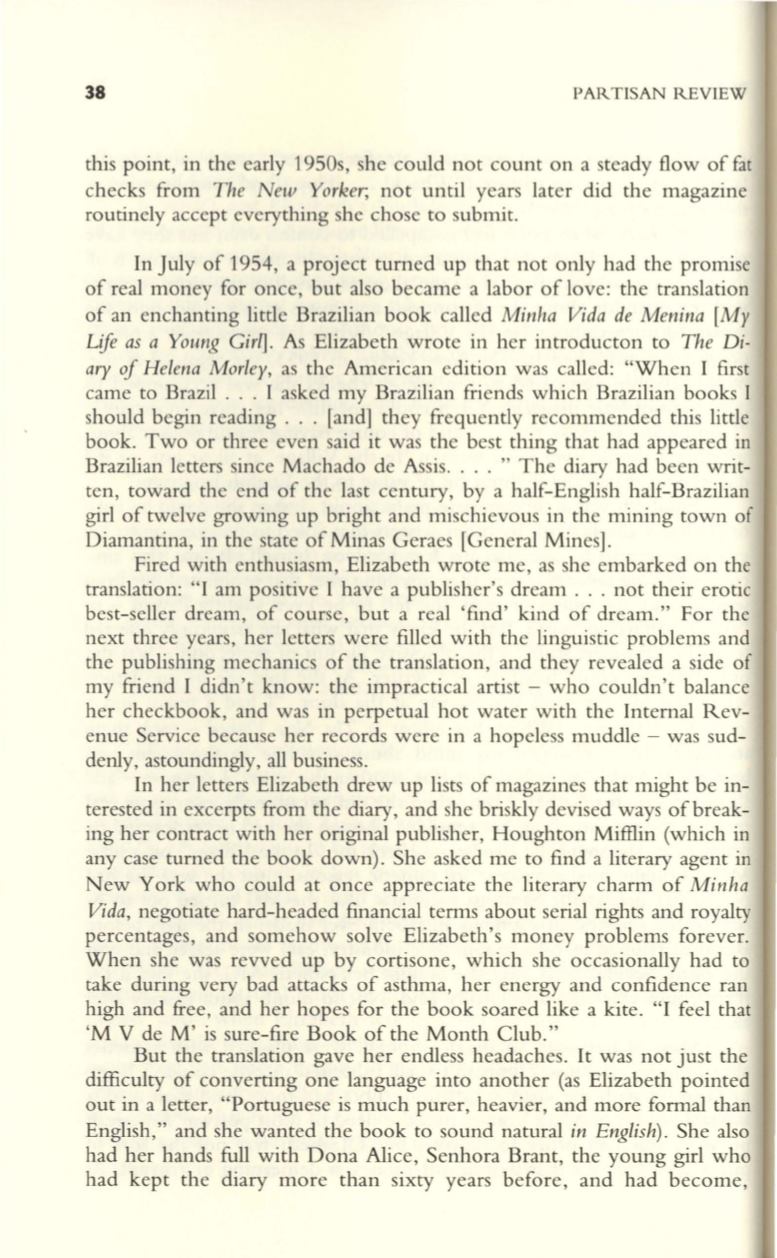
38
PAIl...TISAN REVIEW
this point, in the early 1950s, she could not count on a steady flow of fat
checks from
The New Yorker;
not until years later did the magazine
routinely accept everything she chose to submit.
In July of 1954, a project turned up that not only had the promise
of real money for once, but also became a labor of love: the translation
of an enchanting little Brazilian book called
Minha Vida de Menina [My
Life as a Young Girl].
As Elizabeth wrote in her introducton to
The
Di–
ary of Helena Morley,
as the American edition was called: "When I first
came to Brazil ... I asked my Brazilian friends which Brazilian books I
should begin reading ... [and] they frequently recommended this little
book. Two or three even said it was the best thing that had appeared in
Brazilian letters since Machado de Assis.... " The diary had been writ–
ten, toward the end of the last century, by a half-English half-Brazilian
girl of twelve growing up bright and mischievous in the mining town of
Diamantina, in the state of Minas Geraes [General Mines].
Fired with enthusiasm, Elizabeth wrote me, as she embarked on the
translation: "I am positive I have a publisher's dream ... not their erotic
best-seller dream, of course, but a real 'find' kind of dream." For the
next three years, her letters were filled with the linguistic problems and
the publishing mechanics of the translation, and they revealed a side of
my friend I didn't know: the impractical artist - who couldn't balance
her checkbook, and was in perpetual hot water with the Internal Rev–
enue Service because her records were in a hopeless muddle - was sud–
denly, astoundingly,
all
business.
In her letters Elizabeth drew up lists of magazines that might be in–
terested in excerpts from the diary, and she briskly devised ways of break–
ing her contract with her original publisher, Houghton Mifflin (which
in
any case turned the book down). She asked me to find a literary agent in
New York who could at once appreciate the literary charm of
Minha
Vida,
negotiate hard-headed financial terms about serial rights and royalty
percentages, and somehow solve Elizabeth's money problems forever.
When she was revved up by cortisone, which she occasionally had to
take during very bad attacks of asthma, her energy and confidence ran
high and free, and her hopes for the book soared like a kite. "I feel that
'M V de M' is sure-fire Book of the Month Club."
But the translation gave her endless headaches. It was not just the
difficulty of converting one language into another (as Elizabeth pointed
out in a letter, "Portuguese is much purer, heavier, and more fonnal than
English," and she wanted the book to sound natural
in English) .
She also
had her hands full with Dona Alice, Senhora Brant, the young girl who
had kept the diary more than sixty years before, and had become,


